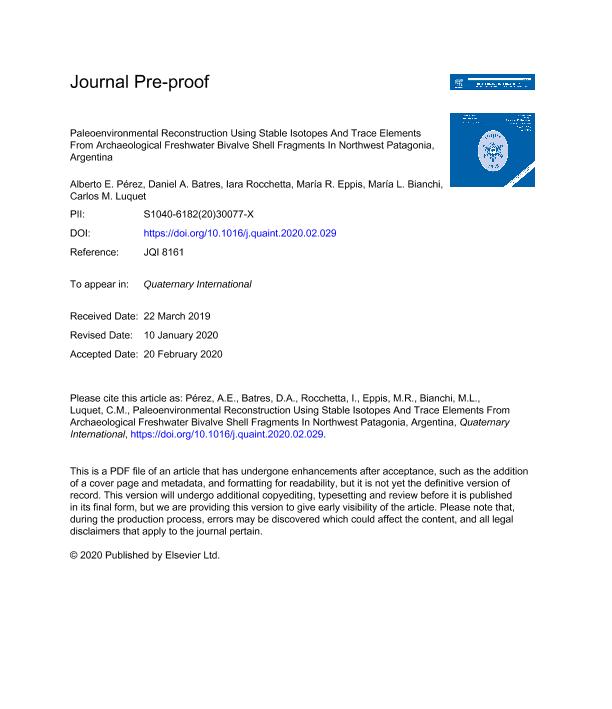Mostrar el registro sencillo del ítem
dc.contributor.author
Perez, Alberto Enrique

dc.contributor.author
Batres, Daniel Alejandro

dc.contributor.author
Rocchetta, Iara

dc.contributor.author
Eppis, María
dc.contributor.author
Bianchini, María Laura

dc.contributor.author
Luquet, Carlos Marcelo

dc.date.available
2020-09-03T19:19:39Z
dc.date.issued
2020-05
dc.identifier.citation
Perez, Alberto Enrique; Batres, Daniel Alejandro; Rocchetta, Iara; Eppis, María; Bianchini, María Laura; et al.; Paleoenvironmental reconstruction using stable isotopes and trace elements from archaeological freshwater bivalve shell fragments in Northwest Patagonia, Argentina; Pergamon-Elsevier Science Ltd; Quaternary International; 547; 5-2020; 22-32
dc.identifier.issn
1040-6182
dc.identifier.uri
http://hdl.handle.net/11336/113164
dc.description.abstract
Stable oxygen and carbon isotopes (18O and 13C) and the trace elements, manganese (Mn) and strontium (Sr) were analyzed in archaeological bivalve (Diplodon chilensis) shell fragments recovered from Parque Diana Cave, Patagonia, Argentina, to analyze the temporal trends of human occupation of the North Patagonia forest with climatic conditions recorded at regional scale but poorly known at local scale for this site. We established a stratigraphic sequence of thirteen 10 cm thick layers spanning the period c. 2370 BP to c. 580 BP and grouped these layers into three cultural components.According to this region´s climate, with rain and snow concentrated in winter and dry summers, our data suggest that these components are contemporary with three climatic periods. A dry period indicated by high values of δ18Oshell, δ13Cshell and Sr/Ca ratio (Mn/Ca ratio does not show any significant trend), in the Lower component is associated with brief incursions of hunter-gatherers from the eastern steppe. In the Middle component, low δ18Oshell, δ13Cshell and Sr/Ca ratios, suggest a humid climate with increased supply of meteoric and/or melt-water along with terrestrial plants organic matter and soil carbonates to the river. According to the archaeological evidence, in this period, hunter gatherers from the Pacific coast and forest started to colonize the area across the Andes cordillera. At the beginning of the Upper component, which is mostly contemporary with the expression of the Medieval Climatic Anomaly (MCA), the proxies are not totally coincident but a tendency to progressively drier conditions could be inferred. Except for layer 4 for δ18Oshell and layer 5 for Sr/Ca ratio, δ18Oshell, δ13Cshell and Sr/Ca ratio show consistently high levels in the Upper than in the Middle component. In layer 5, δ18Oshell and δ13Cshell are elevated with respect to the Middle component while Sr/Ca ratio remains low. In layer 4, δ13Cshell and Sr/Ca ratio are high while δ18Oshell shows a negative peak. In layers 3 to 1, δ18Oshell, δ13Cshell and Sr/Ca ratio remain at high levels, indicating an arid-warm climate with high aquatic plant productivity, in coincidence with the expression of the MCA reported for this region in a partially contemporaneous period (1080?1250 AD). At this time, the occupation of the site by groups of the same origin as those present in the Middle component became permanent. Extensive and intensive use of local resources in this period can be inferred from the quality and quantity of artifacts recovered.
dc.format
application/pdf
dc.language.iso
eng
dc.publisher
Pergamon-Elsevier Science Ltd

dc.rights
info:eu-repo/semantics/openAccess
dc.rights.uri
https://creativecommons.org/licenses/by-nc-nd/2.5/ar/
dc.subject
ARCHAEOLOGY
dc.subject
FRESHWATER BIVALVES
dc.subject
PALAEOENVIRONMENT
dc.subject
PATAGONIA
dc.subject
STABLE ISOTOPES
dc.subject
TRACE ELEMENTS
dc.subject.classification
Otras Ciencias Biológicas

dc.subject.classification
Ciencias Biológicas

dc.subject.classification
CIENCIAS NATURALES Y EXACTAS

dc.title
Paleoenvironmental reconstruction using stable isotopes and trace elements from archaeological freshwater bivalve shell fragments in Northwest Patagonia, Argentina
dc.type
info:eu-repo/semantics/article
dc.type
info:ar-repo/semantics/artículo
dc.type
info:eu-repo/semantics/publishedVersion
dc.date.updated
2020-06-08T15:08:52Z
dc.identifier.eissn
1873-4553
dc.journal.volume
547
dc.journal.pagination
22-32
dc.journal.pais
Estados Unidos

dc.description.fil
Fil: Perez, Alberto Enrique. Universidad Católica de Temuco; Chile
dc.description.fil
Fil: Batres, Daniel Alejandro. Universidad Católica de Temuco; Chile
dc.description.fil
Fil: Rocchetta, Iara. Consejo Nacional de Investigaciones Científicas y Técnicas. Centro Científico Tecnológico Conicet - Patagonia Norte. Instituto de Investigaciones en Biodiversidad y Medioambiente. Universidad Nacional del Comahue. Centro Regional Universidad Bariloche. Instituto de Investigaciones en Biodiversidad y Medioambiente; Argentina
dc.description.fil
Fil: Eppis, María. Comisión Nacional de Energía Atómica; Argentina
dc.description.fil
Fil: Bianchini, María Laura. Comisión Nacional de Energía Atómica; Argentina
dc.description.fil
Fil: Luquet, Carlos Marcelo. Consejo Nacional de Investigaciones Científicas y Técnicas. Centro Científico Tecnológico Conicet - Patagonia Norte. Instituto de Investigaciones en Biodiversidad y Medioambiente. Universidad Nacional del Comahue. Centro Regional Universidad Bariloche. Instituto de Investigaciones en Biodiversidad y Medioambiente; Argentina
dc.journal.title
Quaternary International

dc.relation.alternativeid
info:eu-repo/semantics/altIdentifier/url/https://www.sciencedirect.com/science/article/abs/pii/S104061822030077X
dc.relation.alternativeid
info:eu-repo/semantics/altIdentifier/doi/http://dx.doi.org/10.1016/j.quaint.2020.02.029
Archivos asociados
